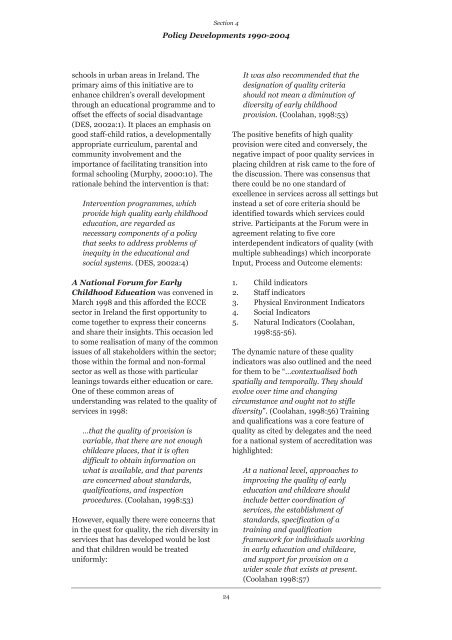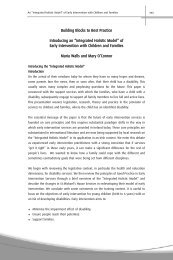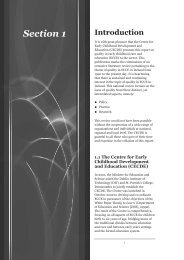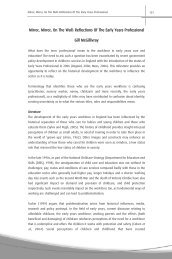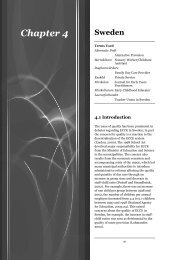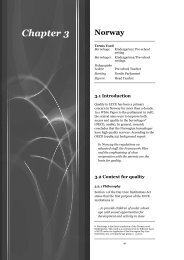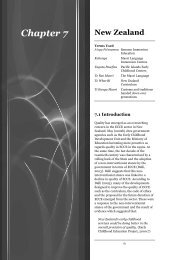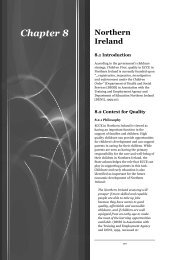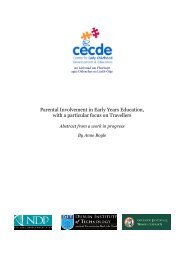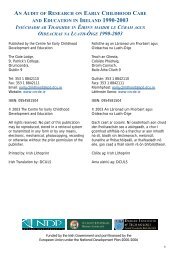Policy Developments 1990-2004 - Centre for Early Childhood ...
Policy Developments 1990-2004 - Centre for Early Childhood ...
Policy Developments 1990-2004 - Centre for Early Childhood ...
You also want an ePaper? Increase the reach of your titles
YUMPU automatically turns print PDFs into web optimized ePapers that Google loves.
Section 4<strong>Policy</strong> <strong>Developments</strong> <strong>1990</strong>-<strong>2004</strong>schools in urban areas in Ireland. Theprimary aims of this initiative are toenhance children’s overall developmentthrough an educational programme and tooffset the effects of social disadvantage(DES, 2002a:1). It places an emphasis ongood staff-child ratios, a developmentallyappropriate curriculum, parental andcommunity involvement and theimportance of facilitating transition into<strong>for</strong>mal schooling (Murphy, 2000:10). Therationale behind the intervention is that:Intervention programmes, whichprovide high quality early childhoodeducation, are regarded asnecessary components of a policythat seeks to address problems ofinequity in the educational andsocial systems. (DES, 2002a:4)A National Forum <strong>for</strong> <strong>Early</strong><strong>Childhood</strong> Education was convened inMarch 1998 and this af<strong>for</strong>ded the ECCEsector in Ireland the first opportunity tocome together to express their concernsand share their insights. This occasion ledto some realisation of many of the commonissues of all stakeholders within the sector;those within the <strong>for</strong>mal and non-<strong>for</strong>malsector as well as those with particularleanings towards either education or care.One of these common areas ofunderstanding was related to the quality ofservices in 1998:…that the quality of provision isvariable, that there are not enoughchildcare places, that it is oftendifficult to obtain in<strong>for</strong>mation onwhat is available, and that parentsare concerned about standards,qualifications, and inspectionprocedures. (Coolahan, 1998:53)However, equally there were concerns thatin the quest <strong>for</strong> quality, the rich diversity inservices that has developed would be lostand that children would be treateduni<strong>for</strong>mly:It was also recommended that thedesignation of quality criteriashould not mean a diminution ofdiversity of early childhoodprovision. (Coolahan, 1998:53)The positive benefits of high qualityprovision were cited and conversely, thenegative impact of poor quality services inplacing children at risk came to the <strong>for</strong>e ofthe discussion. There was consensus thatthere could be no one standard ofexcellence in services across all settings butinstead a set of core criteria should beidentified towards which services couldstrive. Participants at the Forum were inagreement relating to five coreinterdependent indicators of quality (withmultiple subheadings) which incorporateInput, Process and Outcome elements:1. Child indicators2. Staff indicators3. Physical Environment Indicators4. Social Indicators5. Natural Indicators (Coolahan,1998:55-56).The dynamic nature of these qualityindicators was also outlined and the need<strong>for</strong> them to be “…contextualised bothspatially and temporally. They shouldevolve over time and changingcircumstance and ought not to stiflediversity”. (Coolahan, 1998:56) Trainingand qualifications was a core feature ofquality as cited by delegates and the need<strong>for</strong> a national system of accreditation washighlighted:At a national level, approaches toimproving the quality of earlyeducation and childcare shouldinclude better coordination ofservices, the establishment ofstandards, specification of atraining and qualificationframework <strong>for</strong> individuals workingin early education and childcare,and support <strong>for</strong> provision on awider scale that exists at present.(Coolahan 1998:57)24


